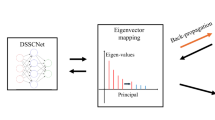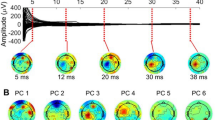Abstract
A novel approach for solving the single-channel signal separation is presented the proposed sparse nonnegative tensor factorization under the framework of maximum a posteriori probability and adaptively fine-tuned using the hierarchical Bayesian approach with a new mixing mixture model. The mixing mixture is an analogy of a stereo signal concept given by one real and the other virtual microphones. An “imitated-stereo” mixture model is thus developed by weighting and time-shifting the original single-channel mixture. This leads to an artificial mixing system of dual channels which gives rise to a new form of spectral basis correlation diversity of the sources. Underlying all factorization algorithms is the principal difficulty in estimating the adequate number of latent components for each signal. This paper addresses these issues by developing a framework for pruning unnecessary components and incorporating a modified multivariate rectified Gaussian prior information into the spectral basis features. The parameters of the imitated-stereo model are estimated via the proposed sparse nonnegative tensor factorization with Itakura–Saito divergence. In addition, the separability conditions of the proposed mixture model are derived and demonstrated that the proposed method can separate real-time captured mixtures. Experimental testing on real audio sources has been conducted to verify the capability of the proposed method.







Similar content being viewed by others
References
Y.I. Abramovich, O. Besson, A. Johnson, Conditional expected likelihood technique for compound-Gaussian and Gaussian distributed noise mixtures. Trans. Signal Process. 64, 6640–6649 (2016)
A. Aissa-El-Bey, N. Linh-Trung, K. Abed-Meraim, A. Belouchrani, Y. Grenier, Under- determined blind separation of nondisjoint sources in the time-frequency domain. IEEE Trans. Signal Process. 55(3), 897–907 (2007)
A. Al-Tmeme, W.L. Woo, S.S. Dlay, B. Gao, Underdetermined convolutive source separation using GEM-MU with variational approximated optimum model order NMF2D. IEEE Trans. Audio Speech Lang. Process. 75(1), 35–49 (2016)
C.E. Cherry, Some experiments on the recognition of speech, with one and with two ears. J. Acoust. Soc. Am. 25(5), 975–979 (1953)
A. Cichocki, R. Zdunek, S.I. Amari, Csiszár’s divergences for non-negative matrix factorization: family of new algorithms. In Proc. Int. Conf. Ind. Compon. Anal. Blind Signal Separat. (ICABSS’06), vol. 3889 (Charleston, SC, 2006), pp. 32–39
R. de Frein, S. Rickard, The synchronized short-time-Fourier-transform: properties and definitions for multichannel source separation. IEEE Trans. Signal Process. 59(1), 91–103 (2011)
C. Févotte, A. Ozerov, Notes on nonnegative tensor factorization of the spectrogram for audio source separation: statistical insights and towards self-clustering of the spatial cues. In 7th International Symposium on Computer Music Modeling and Retrieval, (CMMR 2010) (2010)
C. Févotte, N. Bertin, J.-L. Durrieu, Nonnegative matrix factorization with the Itakura–Saito divergence With application to music analysis. Neural Comput. 21, 793–830 (2009)
D. FitzGerald, M. Cranitch, E. Coyle, Non-negative tensor factorization for sound source separation. In Irish Signals and Systems Conf. Dublin, Ireland, (2005)
B. Gao, W.L. Woo, S.S. Dlay, Variational regularized 2-D nonnegative matrix factorization. IEEE Trans. Neural Netw. 23(5), 703–716 (2012)
B. Gao, W.L. Woo, S.S. Dlay, Unsupervised single-channel separation of nonstationary signals using Gammatone filterbank and Itakura–Saito nonnegative matrix two-dimensional factorizations. IEEE Trans. Circuits Syst. 60(3), 662–675 (2013)
S. Ge, J. Han, M. Han, Nonnegative mixture for underdetermined blind source separation based on a tensor algorithm. Circuits Syst. Signal Process. 34(9), 2935–2950 (2015)
M. Goto, H. Hashiguchi, T. Nishimura, R. Oka, RWC music database: music genre database and musical instrument sound database. In Proc. Int. Sym. Music Inf. Retrieval (ISMIR), Baltimore (2003), pp. 229–230
Y. Guo, G.R. Naik, H. Nguyen, Single channel blind source separation based local mean decomposition for Biomedical applications. In Proc. IEEE 35th Annual Int. Conf. Engineering in Medicine and Biology Society (EMBC) (2013), pp 6812–6815
H. Guo, X. Li, L. Zhou, Z. Wu, Single-channel speech separation using dictionary-updated orthogonal matching pursuit and temporal structure information. Circuits Syst. Signal Process. 34(12), 3861–3882 (2015)
M. Harva, A. Kabán, Variational learning for rectified factor analysis. Signal Process. 87(3), 509–527 (2007)
K.E. Hild II, H.T. Attias, S.S. Nagarajan, An expectation–maximization method for spatio–temporal blind source separation using an AR-MOG source model. IEEE Trans. Neural Netw. 19(3), 508–519 (2008)
K. Hu, D.L. Wang, Unvoiced speech separation from nonspeech interference via CASA and spectral subtraction. IEEE Trans. Audio Speech Lang. Process. 19(6), 1600–1609 (2011)
A. Hyvärinen, Fast and robust fixed-point algorithms for independent component analysis. IEEE Trans. Neural Netw. 10(3), 626–634 (1999)
S. Kim, C.D. Yoo, Underdetermined blind source separation based on subspace representation. IEEE Trans. Signal Process. 57(7), 2604–2614 (2009)
D. Kitamura, N. Ono, H. Sawada, H. Kameoka, H. Saruwatari, Determined blind source separation unifying independent vector analysis and nonnegative matrix factorization. IEEE Trans. Audio Speech Lang. Process. 24(9), 1626–1641 (2016)
R. Kompass, A generalized divergence measure for nonnegative matrix factorization. Neural Comput. 19(3), 780–791 (2007)
V.A.C. Kumar, V.R. Rao, A. Dutta, Performance analysis of blind source separation using canonical correlation. Circuits Syst. Signal Process. 32, 1–16 (2017)
D.D. Lee, H.S. Seung, Learning the parts of objects with nonnegative matrix factorization. Nature 401, 788–791 (1999)
D.D. Lee, H.S. Seung, Algorithms for non-negative matrix factorization. In Proc. NIPS (2000), pp. 556–562
C.J. Lin, On the convergence of multiplicative update algorithms for nonnegative matrix factorization. IEEE Trans. Neural Netw. 18(6), 1589–1596 (2007)
W. Lu, B.N. Zhang, Single channel time-varying amplitude LFM interference blind separation using MHMPSO particle filtering. In Proc. IEEE Int. Conf. Signal and Image Processing Applications (ICSIPA) (2013), pp. 425–430
G. Lu, M. Xiao, P. Wei, H. Zhang, A new method of blind source separation using single-channel ICA based on higher-order statistics. Math. Probl. Eng.. Article ID 439264 (2015)
D. Luengo, I. Santamaría, L. Vielva, C. Pantaleón Underdetermined blind separation of sparse sources with instantaneous and convolutive mixtures. In IEEE 13th Workshop on: Neural Networks for Signal Processing, NNSP’03. 2003,(2003), pp. 279–288
D. Luengo, I. Santamar´ıa, L. Vielva, A general solution to blind inverse problems for sparse input signals. Neurocomputing 69(1), 198–215 (2005)
A. Mansour, N. Benchekroun, C. Gervaise, Blind separation of underwater acoustic signals. In Proc. 6th International Conference on Independent Component Analysis and Blind Signal Separation (ICA’06), vol 3889 (2006), pp. 181–188
B. Mijovic, M. Vos, D. Gligorijevic, I.J. Taelman, S.V. Haffel, Source separation from single-channel recordings by combining empirical-mode decomposition and independent component analysis. IEEE Trans. Biomed. Eng. 57(9), 2188–2196 (2010)
M. Niknazar, H. Becker, B. Rivet, C. Jutten, P. Comon, Blind source separation of underdetermined mixtures of event-related sources. Sig. Process. 101, 52–64 (2014)
P. Paatero, U. Tapper, Positive matrix factorization: a non-negative factor model with optimal utilization of error estimates of data values. Environmetrics. 5(2), 111–126 (1994)
P. Parathai, W.L. Woo, S.S. Dlay, B. Gao, Single-channel blind separation using L1-sparse complex non-negative matrix factorization for acoustic signals. J. Acoust. Soc. Am. 137(1), 42–49 (2017)
T. Peng, Y. Chen, Z.W. Liu, Time-frequency domain blind source separation method for underdetermined instantaneous mixtures. Circuits Syst. Signal Process. 34(12), 3883–3895 (2015)
R.K. Prasad, H. Saruwatari, K. Shikano Single channel speech enhancement: MAP estimation using GGD prior under blind setup. In Proc. 5th International Conference on Independent Component Analysis and Blind Signal Separation (ICA’04), vol. 3195 (2004), pp. 873–880
R. Schachtner, G. Pöppel, A.M. Tomé, E.W. Lang, A Bayesian approach to the lee–seung update rules for nmf. Pattern Recogn. Lett. 45, 251–256 (2014)
Signal Separation Evaluation Campaign (SiSEC 2016). (2016). http://sisec.wiki.irisa.fr. Accessed 3 May (2017)
M.K. Su, T.D. Tan, J.O. Tobias, P. Gunnar, On the entropy computation of large complex gaussian mixture distributions. IEEE Trans. Signal Process. 63(17), 4710–4723 (2015)
E. Vincent, R. Gribonval, C. Févotte, Performance measurement in blind audio source separation. IEEE Trans. Speech Audio Lang. Process. 14(4), 1462–1469 (2005)
F. Weninger, A. Lehmann, B. Schuller, OpenBliSSART: design and evaluation of a research toolkit for blind source separation in audio recognition tasks. In Proc. IEEE Int. Conf Acoustics, Speech and Signal Processing (ICASSP) (2011), 1625–1628
Y. Xiang, S.K. Ng, V.K. Nguyen, Blind separation of mutually correlated sources using precoders. IEEE Trans. Neural Netw. 21(1), 82–90 (2010)
S. Xie, L. Yang, J.-M. Yang, G. Zhou, Y. Xiang, Time-frequency approach to underdetermined blind source separation. IEEE Trans. Neural Netw. Learn. Syst. 23(2), 306–316 (2012)
Ö. Yilmaz, S. Rickard, Blind separation of speech mixtures via time-frequency masking. IEEE Trans. Signal Process. 52(7), 1830–1847 (2004)
H. Zhu, S. Zhang, H. Zhao, Single-channel source separation of multi-component radar signal with the same generalized period using ICA. Circuits Syst. Signal Process. 35(1), 353–363 (2016)
M. Zibulevsky, B.A. Pearlmutter, Blind source separation by sparse decomposition in a signal dictionary. Neural Comput. 13(4), 863–882 (2001)
Author information
Authors and Affiliations
Corresponding author
Additional information
Publisher’s Note
Springer Nature remains neutral with regard to jurisdictional claims in published maps and institutional affiliations.
Rights and permissions
About this article
Cite this article
Parathai, P., Tengtrairat, N., Woo, W.L. et al. Single-Channel Signal Separation Using Spectral Basis Correlation with Sparse Nonnegative Tensor Factorization. Circuits Syst Signal Process 38, 5786–5816 (2019). https://doi.org/10.1007/s00034-019-01156-4
Received:
Revised:
Accepted:
Published:
Issue Date:
DOI: https://doi.org/10.1007/s00034-019-01156-4




